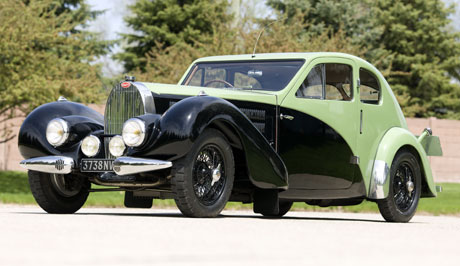SCM Analysis
Detailing
| Vehicle: | 1938 Bugatti Type 57C Special |
| Number Produced: | 535 (T57); 106 (T57C); 15 (T57GR) |
| Tune Up Cost: | $5,000 |
| Distributor Caps: | $400 |
| Chassis Number Location: | Brass plate on left side firewall; on upper crankcase at engine rear left |
| Engine Number Location: | Same places as chassis number |
| Club Info: | Club: American Bugatti Club |
| Website: | http://www.americanbugatticlub.org |
This 1938 Bugatti Type 57C Special Coupe sold for $1,375,000, including buyer’s premium, at Gooding & Company’s auction at Pebble Beach, California, on August 15, 2009.
Its fascinating provenance is indisputable and all the stories about this very special Type 57C Special Coupe and its chassis number and registration would take too much time and space to tell. But let us look at some hard facts about this factory demonstrator.
All the Works drivers drove this car
The 57C Special was built in 1937 and used by the whole Bugatti Works team. The car was registered in the name of Ettore Bugatti and driven by the factory for nearly 20 years.
There are a number of pictures taken by Jean Bugatti that show the car at various races. Jean Pierre Wimille is pictured behind the wheel, and we can even spot the coupe at the 1939 Le Mans race on the starting grid during practice.
There’s no doubt that all the other Works drivers at the time used 57335, including Benoist and Veyron. From the Le Mans pictures, we can tell the car was painted in a slightly different color scheme at that time.
It was finally invoiced to the famous Belgian Bugatti dealer Jean de Dobbeleer on January 31, 1959, for 1,000FF (about $2-really). De Dobbeleer exported it to the U.S. and did a number of fiddles with the engine and chassis number, for taxation reasons.
The Special coupe was sold by the Works with engine number 340; however, factory documentation tells us that in June 1939, the car also had engine 486 when a Mr. Peigues took the car to Luxembourg.
So 57335 arrived in Belgium with a replacement engine numbered 340, which is ex-57449 (not from 57557 as stamped on the engine). It gets even more confusing: There is another engine stamped 540-57335, with the Bugatti chassis number 57529. And customer chassis 57335 was originally delivered with engine 223 to agent “Monestier” in Lyon with a delivery date of May 26, 1937, two years later than delivery of any similar chassis numbers in the list. Go figure. There are still mysteries to be solved.
What this car does have is history
So what does that mean regarding the originality of this 57C Special coupe? To me, the engine number of a Works experimental car (which this is) is nowhere near as important as it is on a normal production car, where the engine number is allocated to a specific chassis number. One simply can’t assign a value to this car using “matching numbers” criteria.
What this 57C does have is history. The body is a one-off design, many special details are unique, and the provenance-even if not complete in every detail-is fascinating. The car is loaded with anecdotes and simply cannot be compared to a standard Type 57C Ventoux or coupe.
Amazingly, all three caretakers of the car after de Dobbeleer were well aware what a piece of Bugatti history they owned, so the car was not destroyed by a restoration that would have robbed it of its soul. All the special features are still with the car (even the sliding bars to mount the jack under the rear axle are still in place.)
But the car can be considered attractive only to a limited number of Bugatti connoisseurs. It is a unique piece of history that looks like a standard Type 57, but with a one-off body that is a matter of personal taste. Should it be worth more than a more rakish 57S? That’s a hard question to answer.
A far more attractive Type 57C Atalante sold at the same auction a day later for $880k, including buyer’s premium. Considering that there are about 40 Atalante Type 57s in existence and our subject car is a one-off car with bulletproof provenance, I say at $1.375m, it was very well bought indeed.
